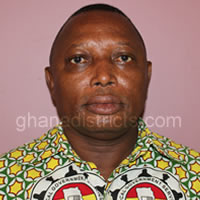Physical and Natural Environment
This section examines the physical characteristics of the Municipality and their implications for fostering sustained socio-economic development. Specific geo-physical features that have been considered include location and size climate, vegetation, relief, geology, soils, conditions of both the natural and built environment, land management practices, impact of climate change and human activities on the environment and in the Municipality.
Location and Size
The Wenchi Municipality is located in the western part of Brong Ahafo Region of Ghana and lies within latitudes 7o 30’ South and 7o 15’ North and longitudes 2o 17’ West and 1o 55’ East. It covers a total land area of 1,145 square kilometres and shares boundaries with Banda and Kintampo South Districts to the North, Techiman Municipal and Techiman North District to the East, Sunyani West to the South, and Tain District to the West.
Wenchi, the Municipal capital, is 56km to Sunyani and 29km from Techiman which is arguably the commercial town (largest market in the region) of the Brong Ahafo Region. Its closeness to Techiman, a major national market, poses several benefits for agricultural production and agro-processing and farmers especially must be sensitized and supported to take advantage of this opportunity. Figure 1below shows the location of Wenchi Municipality in the regional and national context, while Figure 2 shows the location of communities in the Municipality.
Relief and Drainage
The relief of Wenchi Municipal is shown in Figure 1. The topography is predominantly undulating with gentle slopes of less than 1% inclination. The land generally rises from 30m above sea level to over 61m in the North/West. Apart from the North-western high land; the other areas are basins of the tributaries of the Volta and therefore low lying.
Generally, the Municipality is well drained as shown in the relief map in figure 1. The Black Volta marks the northern boundary of the Municipality with the Northern Region. The major rivers, which serve the communities in the Municipality, are Tain, Subin, Kyiridi, Trome and Yoyo. Tain, Subin and the Black Volta Rivers flow throughout the year and such could be dammed to support continues agricultural production and safe water provision.
Climate
Temperature in the Municipality is generally high, averaging about 24.5oC. Average maximum temperature is 30.9 (oC) and a minimum of 21.2 (oC). The hottest months are February to April. Table 1.2 shows the mean monthly, annual maximum, minimum temperatures and changes in mean maximum and minimum temperatures in the Municipality.
The municipality has two main seasons – rainy and dry seasons. The rainy season occurs between April to October. The average annual rainfall is between 1,140 – 1,270 mm. The dry season, also known as the harmattan, occurs between or from November and February. This long period of dryness makes the Municipality very vulnerable and susceptible to bush fires. Bush burning is therefore very rampant during the dry seasons. This has however, been managed through community education and fire volunteers who are working in the municipality.
The prevailing climatic conditions in the Municipality constitute important parameters for development. The temperature has some influence on the quality and quantity of land cover. The rainfall pattern is characterised by seasonality, which is a limiting factor to crop cultivation and plant growth.
Vegetation
The Municipality falls within the moist-semi-deciduous forest and the Guinea Savannah woodland vegetation zones. The Guinea savannah woodland represents an eco-climatic zone, which has evolved in response to climatic and edaphic limiting factors and has been modified substantially by human activities.
Timber species like Odum, Sapele, Wawa and Mahogany are found in places such as Nwoase. The groves at Nwoase show that with protection, forest in the Municipality can be very productive because the soils in the sacred groves appear more fertile compared to soils lying a few metres away which have been laid bare by intensive cultivation and other unsustainable uses. In the grooves, wildlife like deer and antelope are found.
The activities of the Nwoase traditional area towards protecting the forest and wildlife won them an award from the Government in 2004 (2010 Population and Housing Census, GSS). Other forest reserves are Sawsaw and Yaya. The combination of the vegetation zones – guinea savannah, transitional zone and the forest permit the cultivation of variety of crops – cereal, tubers and vegetables and even animal rearing. Figure 3 shows the location of the numerous natural resources in the Municipality.
Fig. 1: Location of Wenchi Municipality in the National and Regional Context
Figure 3.1 Map of Wenchi Municipality
Fig. 2: Map of Wenchi Showing the Location of Communities
Figure 3: Resource Potential of Wenchi Municipality
Soils
A greater proportion of Wenchi Municipality falls under the savannah ochrosol with some lithosols. The land is generally low lying and most of the soils are sandy loam and in the valleys, loamy soils exist. The soils are fairly rich in nutrients and are suitable for the cultivation of savannah, transitional and forest crops such as maize, yams, cocoyam, and cassava. There are clay deposits for pottery industry and burnt bricks.
Geology and Minerals
Geologically, the municipality is underlained mostly by Birrimain rock formation. The area falls under the Lower Birrimain, which consists of such metamorphosed sediments as phyillite and schist. There are also granite and granodiorite in the southeast and western parts of the Municipality. There are several rock deposits and outcrops in the Municipality within the outstretch of land between Wenchi Town and Buoku community.
The rocks are currently being quarried for road and building construction. There are over ten (10) companies in the municipality that are mining these rock deposits with room for several other companies. The exploitation of these rock deposits holds several benefits including employment creation and expansion of the local construction industry. Measures should however be put in place to control its negative environmental impacts.
Biodiversity
Biodiversity forms the foundation of the vast array of eco-system services that critically contribute to human well-being. Plants, animals, aquatic species, fora and fauna are protected from human activities that endanger living organisms within our Municipality. The Assembly incorporates Strategic Environmental Impact Assessment (SEA) in its MTDP that guides projects and programmes implementation.
This helps subject projects and programmes to careful environmental tools such as Internal Consistency Matrix and Sustainability Matrix that limit negative impacts that such projects may have on biodiversity and environment in general. Site Sensitivity Assessment is conducted and screening reports submitted to Environmental Protection Agency (EPA) for permits before projects and programmes are implemented. The site sensitivity assessment takes into consideration physical, biological and cultural resources that could be endangered as a result of project and programme implementation.
In order to protect biodiversity and the environment, the Assembly has two (2) Officers in charge of Environmental Safeguards. The responsibility of these Officers is to take all Assembly projects through site sensitivity assessment and submit screening reports to Environmental Protection Agency and Ministry of Local Government Rural Development in order to limit proposed negative impacts a particular project or programme might have on the biological species and the environment.
Climate Change
The rainfall pattern in the municipality is characterized by seasonality, which is a limiting factor to crop cultivation and plant growth. The municipality has two main seasons – rainy and dry seasons. The rainy season occurs between April and October with a short dry spell in August. The average annual rainfall is about 1,140 – 1,270mm. Temperatures I n the municipality are generally high, averaging about 24.5 degree celsius.
Average maximum temperature is 30.90C and a minimum of 21.2 degree celsius. Climate change is now a major hindrance to successful agricultural development and it adversely affects agricultural activities since farming in the municipality is rain-fed. Rain fall pattern is changing, the heat and intensity of the sun is increasing due to the negative effect of human activities on the environment. These negative effects are the indiscriminate felling of trees and other forms of pollution, which have seriously affected the rainfall pattern.
Natural and man-made disasters
Disaster in the Municipality come in the form of fire, rainfall (flooding), severe wind (storm) and pest infestation. Fire disaster occur in homes through improper handling of energy (gas, electricity and charcoal). The National Disaster Management Team in collaboration with the Department of Agriculture within the municipality are educating the public on climate change and disaster risk reduction programmes aimed at improving the environment.
The Municipal Fire Division also educates traders and the general public on market safety and how to prevent fire outbreak. The Municipal Agriculture Directorate and NADMO also educate farmers on the need not to farm along river banks to prevent rivers from drying up. The two departments should be adequately resourced to fight diseases and pest infestation which tend to destroy large hectares of cultivated lands. Through intensive public education, such disasters could be prevented.
Aesthetic features
The Municipality is endowed with many aesthetic features which have high potentials. Aesthetic features in the municipality are the Nchiraa Waterfalls, Nwoase, Yaya and Sawasaw forest reserves, BONO SO (The hole where the people Wenchi are believed to have originated from), the Colonial Courts and Prisons, and the Mausoleum containing the tomb of Dr K.A., Busia (Prime Minister of Ghana, Second Republic, 1969).
In order to develop the tourism potentials of the municipality, there is the need to improve upon physical accessibility, especially the road to the Nkyiraa Waterfalls and other tourist sites. There are also hotels and guest houses in the municipality which could be upgraded to first class standard to enhance tourism.
Land Management
Land management in the municipality is in the custody of the government (the Municipal Assembly), the traditional authorities and private individuals who have been leased land over a period of years. Agriculture lands are mostly cultivated by family members who owned the lands. Private individuals are leased agriculture lands based on ‘abunu system’ where produce is divided into two parts between the land owner and the private individual with ‘abusa system’ where produce is divided into three parts with the land owner taking a third of the produce.
Natural Resource Utilization
The Municipality is endowed with vast natural resources which when utilized will increase wealth and well-being of people. Granite and sand deposit, forest reserves, clay deposit, streams and rivers are some of the economic resources which can be harnessed. The huge deposit of granite is currently been processed to quarry dust, gravels and chippings for construction of roads and buildings.
The Municipality has vast land for agriculture which employs majority of the people. Agriculture in the municipality is still done on subsistence basis with simple farm tools such as hoes and cutlass. If Agriculture could be seen as a business and mechanized agriculture techniques employed, then, the agriculture resources could fully be utilized. These would change the face of agriculture in the Municipality from subsistence farming to commercial/ plantation agriculture with combine harvesters, harrows, ridgers and mounds, then, food sufficiency both locally and nationally could be achieved.
The water resources in the Municipality are Rivers Tain, Trome, Subin, Yoyo, Kyiridi, Gufo, Kokroko, Atwin, Buasu, Botim and others There are other minor rivers and streams also in various areas in the Municipality. Rivers such as Tain, Subin and the Black Volta flow throughout the year. These can be dammed to support continuous agriculture production and safe water supply.
Environment
Conditions of the Built Environment
This aspect highlights on the way of life of the people in terms of their shelter, and living conditions and practices that have direct bearing on the environment. The built environment of the Municipality is made up of the houses and its environs in towns and villages. The environmental condition of the communities both large and small is characterized by poor housing conditions such as; exposed foundations, leaking roofs, cracked walls, and dilapidated wooden structures.
Settlement layout though planned, the undulating nature of the built environment hinders the clear arrangement of housing within settlements. The creation of gullies to uncontrolled drainage along the roads particularly feeder roads have destroyed most access routes in communities, exposed building foundations, created stagnant waters and choked gutters. There is haphazard construction of buildings in some settlements due to non-compliance with settlement schemes.
This has resulted in the construction of building on plots zoned for other purposes like education, sanitation, health, roads among others. The Assembly has initiated steps to help improve the conditions of the build environment. The Assembly now has Department of Urban Roads, which has compiled and submitted data on drains and gullies to the Ministry of Roads and Highways for consideration. The contractors working on the Wenchi town roads have now resumed to site to complete works on the town roads.
a). Conditions of the Natural Environment
The vegetation consisting of both tall trees and grasses constitute the critical element of the natural environment in the municipality. Over the years, however, over reliance on fuel wood for cooking, bush fires, charcoal burning, the activities of chainsaw operators and poor farming practices (slash and burn method of clearing the land) constitute the major activities, which degrade the environment. The cumulative effect is that secondary vegetation occurs in cultivated areas.
In the semi-derived savannah areas, there is the absence of large economic trees as a result of logging, charcoal burning and mechanized farming. The nature of the changing vegetation has also affected the soil condition and how it can serve agricultural production. Gradually, soil fertility is being lost due to deforestation, bush burning, continuous cropping and sand winning.
The drainage system in the Municipality is gradually changing. The water levels of the rivers and streams in the municipality are falling. This is particularly due to clearing along river banks for farming activities.
The climate is also to some extent gradually changing. This is being experienced from the change in rainfall pattern and timing, and the general temperature of the municipality. Farmers at the mercy of the weather, now find it difficult to predict the planting season. The long term effect of the natural environment if not checked could affect the Municipality ecology and its effect on agriculture, industry and service sector.
Implication for Development-Physical and Natural Environment
The levels of interactions among the various features and characteristics show both positive and negative developmental implication. The municipality abounds in natural and economic resources such as granite and sand deposit, clay deposits, arable land, streams and rivers which can be harnessed for development.
The huge deposit of granite is currently been processed to quarry dust, gravels, chippings for construction of roads and buildings. There is also favourable climatic condition, fertile land/soil and forest reserve which attract more people into the municipality to do farming, lumbering and other activities.
Available water for irrigation at areas such as Subinso No.1 & 2, Nwoase, Yoyo, Akrobi and Asubingya where Rivers such as Tain, Subin, Kyiridi flow throughout the year, offer great potential for reliable irrigation systems to support continuous agricultural production and improve income levels of farmers.
In spite of these potentials, the destructive activities by man such poor farming practices, illegal felling of trees and bush burning is affecting agricultural productivity. There is therefore the need to put stringent measures in place to check these activities.
Date Created : 11/21/2017 4:15:19 AM






 facebook
facebook X (twitter)
X (twitter) Youtube
Youtube +233 593 831 280
+233 593 831 280 0800 430 430
0800 430 430 GPS: GE-231-4383
GPS: GE-231-4383 info@ghanadistricts.com
info@ghanadistricts.com Box GP1044, Accra, Ghana
Box GP1044, Accra, Ghana